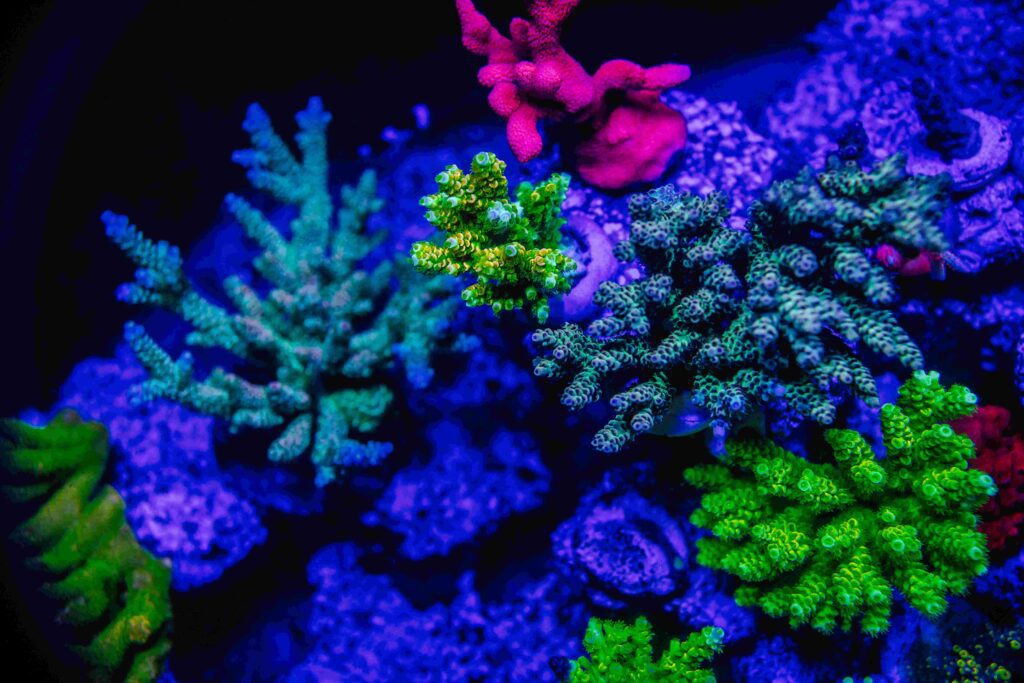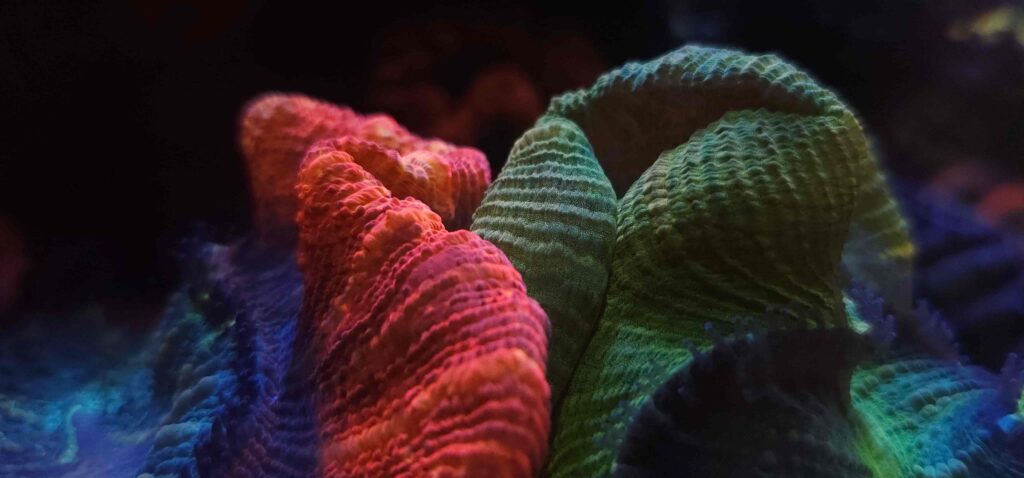Table of Contents
Obtaining food by corals – Introduction
In this article, I will describe the fascinating topic of coral feeding. Obtaining food by corals occurs in two main ways:
- internal processes,
- heterotrophy.
Furthermore, corals can utilize three feeding methods:
- photosynthesis,
- filtering,
- predation.
Photosynthesis – obtaining food
Obtaining food through photosynthesis is the primary method of nutrition for most corals (excluding NPS corals). Corals form endosymbiotic relationships with microscopic algae called zooxanthellae. These algae live within coral cells and are capable of photosynthesis, meaning they produce nutrients such as carbohydrates and amino acids for the corals. In return, corals provide the zooxanthellae with shelter and the substances needed for photosynthesis.
The photosynthesis process in corals occurs in several stages. Initially, chlorophylls in the zooxanthellae absorb energy from light. This energy is then used to conduct chemical reactions that produce glucose.
Oxygen and by-products are also released during photosynthesis. However, it’s important to remember that the photosynthesis process in corals is particularly sensitive to changes in aquarium conditions, such as fluctuations in temperature or water pH. Under unfavorable conditions, zooxanthellae may become damaged, inhibiting photosynthesis, which can lead to coral weakening or even death.
Additionally, obtaining food through photosynthesis allows corals to meet most of their energy needs. Photosynthesis provides them with sufficient energy for survival. However, to support growth, corals require additional energy.

Food filtering – obtaining food
Food filtering is another method of obtaining food by corals. Corals possess polyps, which are cylindrical body structures surrounding a mouth opening. Corals have numerous polyps that can form colonies in various shapes and sizes. Each polyp has the capability to produce spines and mucus, which aid in capturing food and protecting the coral from predators.
The spines are small protein-based protrusions that extend from the polyp bodies. They serve to capture food and defend against predators and competitors. These spines are flexible and mobile, allowing coral polyps to react swiftly to environmental stimuli. They are also coated in a sticky substance (mucus) that helps attract small organisms.
Mucus is secreted by coral polyps in response to food presence in the water. This mucus covers the polyp spines and creates a kind of net that attracts and traps small plankton, which is then transported to the polyps’ digestive cavity for further processing.

Predation – obtaining food
Predation is another way of obtaining food by corals. Some coral species, such as Trachyphyllia, Fungia, Scolymia, Heliofungia, and many others, display predatory behavior and hunt small organisms like shrimp, small fish, and other invertebrates. These coral species have specialized structures, such as catch appendages, which aid in capturing and digesting prey.
Catch appendages are specialized, mobile protrusions on certain coral species that are used to capture prey. Shaped like hooks, they are highly effective at trapping small organisms.
Once prey is captured, the digestion process begins in the coral’s digestive cavity. Corals utilize enzymes to break down the food, which is then absorbed by their tissues.
Other corals that feed predaciously and benefit from supplemental feeding include Fungia, Trachyphyllia, Heliofungia, Catalaphyllia, Euphyllia, Scolymia, and Acanthastrea—primarily LPS (Large Polyp Stony) corals.

Summary
In summary, this article has described various ways corals obtain food. When choosing to purchase a particular coral, it is essential to understand how to provide it with proper nutrition. While lighting is a key factor in maintaining a successful aquarium, as highlighted in the article, some LPS corals benefit from supplemental feeding with frozen shrimp or smelt. For non-photosynthetic corals, it’s important to provide them with food suitable for filtering. If their nature allows, their diet can also be supplemented with frozen foods.

About the author

Marek Protasewicz
Reefkeeping has been my passion for over 10 years now. I love learning. The hobby has taught me many valuable lessons, patience being the best example. Combining work and passion is my path. I run Crazy Coral, a marine aquarium shop, for a number of years. Building this business from the scratch I learnt from my own mistakes at a heavy cost.
Later I managed a project aimed at development of methods for quick growth of Corals in non-natural conditions. The project was carried out by Get Sales, Poland. Presently, I am responsible for distribution strategy at Reef Factory, of which I am a co-founder. The company produces smart devices for marine aquaristics. The last projects I have been involved in are Social Reef and ReefPedia.



